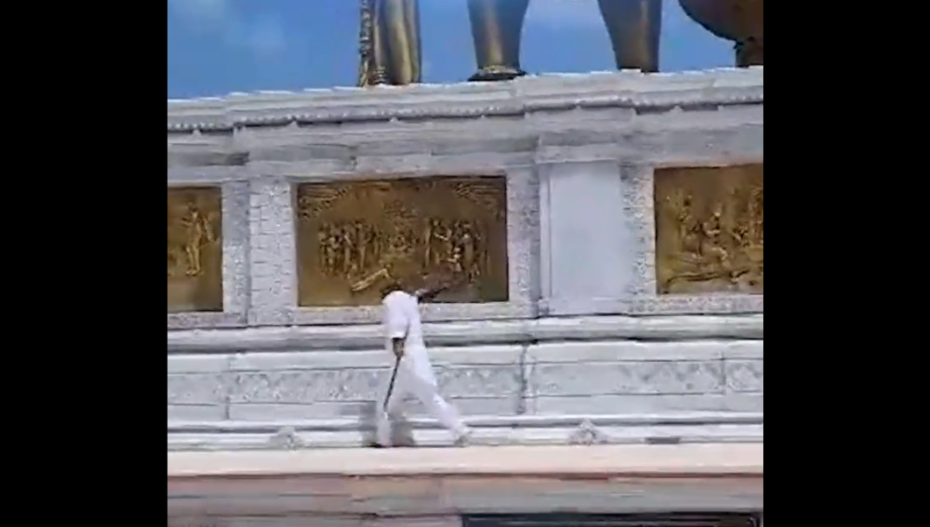Lately, sanatan dharma has become a rallying point for more than one reason. When the national media was busy with the aftershocks of Udhayanidhi Stalin’s statement of eradicating sanatan dharma, another controversy related to sanatan dharma was raging in Gujarat.
The core issue was a mural in a Swaminarayan temple at Salangpur in Saurashtra, in which Hanuman was shown bowing to Sahajanand Swami, the founder of the Swaminarayan sect.
There was also a huge idol of Hanuman, ironically named ‘King of Salangpur’ (yes, that’s the real name, not a translation) donning a Swaminarayan tilak on its forehead.
Some Hindu followers, heads of religious places and priests of Hanuman temples took strong objection to the derogatory depiction of Hanuman and demanded its removal.
Historically, Sahajanand Swami, born Ghanshyam Pande at Chhapaiya near Ayodhya in the late 18th century, founded the Swaminarayan Sect in the early 19th century.
Initially, he became known for performing a few miracles. His claims were questioned by some of the prominent latter-day reformists and writers at the time. He professed to be an avatar of Narayan, the God, and got rechristened as Swaminarayan.
While showing Hanuman under his subservience enraged some people, the devotees of Swaminarayan found it in accordance with their belief of Swaminarayan’s supremacy.
After bitter exchanges online and on the ground, things seem to have fallen into place with the hyperactive efforts of the Rashtriya Swayamsevak Sangh (RSS) and the Vishwa Hindu Parishad (VHP), apparently with the top political leadership’s blessings.
It would be interesting to note that the use of the term ‘sanatan dharma’ instead of Hinduism is a comparatively recent coinage in mainstream media and online platforms. It is emphatically used to suggest some kind of ultimate form of Hinduism, arguably superior to Hindutva, that packs contemporary political messaging.
Also Read: What Is Sanatana Dharma?
Take, for example, the controversy between Moraribapu and the Swaminarayan sect in 2019. Moraribapu, a celebrity performer of Ram katha, passed a tongue-in-cheek comment on Sahajanand Swami that snowballed into a huge controversy.
Moraribapu was at the receiving end of massive trolling, a probable indication that he was, for some reason, out of favour with the big bosses. Otherwise, he professes humanitarian values and has been a long-time supporter of Narendra Modi with equal ease.
The conflict was seen as destabilising ‘Hindu unity’ as perceived by the RSS and related organisations. When a compromise was reached between them and the Swaminarayan sect, the Gujarat VHP issued a statement appealing for forgiveness from both sides. It was an unusual gesture, considering the VHP’s record in alleged cases of hurting religious sentiments.
The noteworthy part, however, was the complete absence of the word ‘sanatan dharma’ from its letter. It mentioned words like ‘Hindu dharma’, ‘Hindu samaj (society)’, and ‘religion, culture and society’ instead.
This particular instance of the mural at Salangpur involved one faction of the sect, namely the Vadtal faction (with its main centre at the central Gujarat town of Vadtal).
The more famous and more influential rival faction, BAPS – which is known for its sprawling Akshardham campuses at Delhi and Gandhinagar, and a record number of temples abroad – observed complete silence.
The RSS and VHP rushed to douse the fire, apparently for the unity of sanatan dharma. But the fact is the BJP cannot afford to displease either side. The Vadtal faction and the Swaminarayan sect at large wield huge clout, which could dent the BJP’s political ease in the state. This also includes Patel power, which is one of the crucial political factors in Gujarat.
Also Read: Four Key Takeaways From BJP’s Historic Win in Gujarat Assembly Elections
A pro-Swaminarayan pamphlet listed the social services of the sect. One of the points claimed is that the sect is the financial backbone of Gujarat, rotating huge amounts of money by arranging big functions, celebrations, erecting buildings etc.
At the same time, right-wing sentiment toward Hanuman, with his close relationship with Ram and Sita, obviously remains non-negotiable – with a notable exception, though. The protectors of ‘sanatan dharma’ were neither hostile nor did they protest vehemently when an image showing Prime Minister Narendra Modi walking the child Ram to a temple was posted on social media on the eve of the foundation-laying ceremony of the temple in Ayodhya.
A sant-sammelan – meeting of the saints – in Gujarat issued wide-ranging demands after the Salangpur murals came to light. Some other groups claiming to be offended by the gesture came rushing to fish the troubled waters, as such events provide ample scope for creating nuisance value and political utility.
But the usual movers and shakers of the game were desperate to strike a compromise.
Ultimately, an agreement was worked out after a meeting with the chief minister of Gujarat, in which it was decided that the murals at the Salangpur temple would be removed. There was no mention of remedial steps for the tilak controversy, though. Both parties agreed to hold another meeting to iron out the differences.
It was reported that ‘Delhi’ took a keen interest in solving the crisis in the wake of the coming Lok Sabha elections. It will be interesting to see for how long this political bandage will succeed in keeping together the various sections of ‘sanatan dharma’.
Urvish Kothari is a writer and satirist based in Gujarat.
This article was first published by The Wire and written by Urvish Kothari












